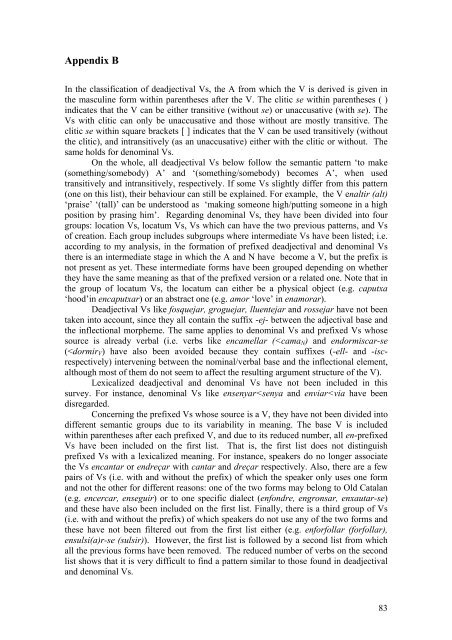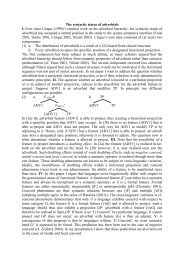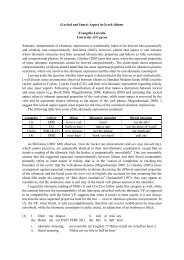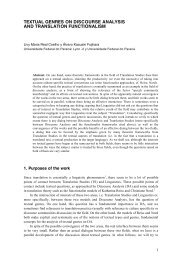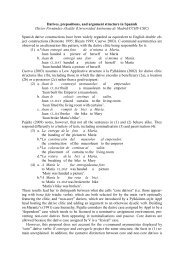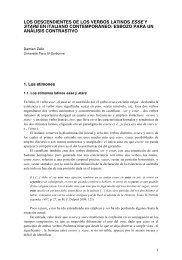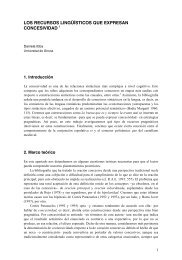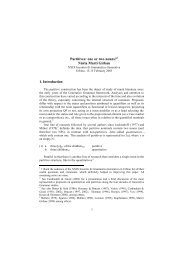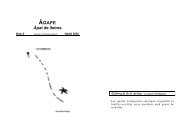Prefixation in English and Catalan - Departament de Filologia ...
Prefixation in English and Catalan - Departament de Filologia ...
Prefixation in English and Catalan - Departament de Filologia ...
Create successful ePaper yourself
Turn your PDF publications into a flip-book with our unique Google optimized e-Paper software.
Appendix B<br />
In the classification of <strong>de</strong>adjectival Vs, the A from which the V is <strong>de</strong>rived is given <strong>in</strong><br />
the mascul<strong>in</strong>e form with<strong>in</strong> parentheses after the V. The clitic se with<strong>in</strong> parentheses ( )<br />
<strong>in</strong>dicates that the V can be either transitive (without se) or unaccusative (with se). The<br />
Vs with clitic can only be unaccusative <strong>and</strong> those without are mostly transitive. The<br />
clitic se with<strong>in</strong> square brackets [ ] <strong>in</strong>dicates that the V can be used transitively (without<br />
the clitic), <strong>and</strong> <strong>in</strong>transitively (as an unaccusative) either with the clitic or without. The<br />
same holds for <strong>de</strong>nom<strong>in</strong>al Vs.<br />
On the whole, all <strong>de</strong>adjectival Vs below follow the semantic pattern ‘to make<br />
(someth<strong>in</strong>g/somebody) A’ <strong>and</strong> ‘(someth<strong>in</strong>g/somebody) becomes A’, when used<br />
transitively <strong>and</strong> <strong>in</strong>transitively, respectively. If some Vs slightly differ from this pattern<br />
(one on this list), their behaviour can still be expla<strong>in</strong>ed. For example, the V enaltir (alt)<br />
‘praise’ ‘(tall)’ can be un<strong>de</strong>rstood as ‘mak<strong>in</strong>g someone high/putt<strong>in</strong>g someone <strong>in</strong> a high<br />
position by pras<strong>in</strong>g him’. Regard<strong>in</strong>g <strong>de</strong>nom<strong>in</strong>al Vs, they have been divi<strong>de</strong>d <strong>in</strong>to four<br />
groups: location Vs, locatum Vs, Vs which can have the two previous patterns, <strong>and</strong> Vs<br />
of creation. Each group <strong>in</strong>clu<strong>de</strong>s subgroups where <strong>in</strong>termediate Vs have been listed; i.e.<br />
accord<strong>in</strong>g to my analysis, <strong>in</strong> the formation of prefixed <strong>de</strong>adjectival <strong>and</strong> <strong>de</strong>nom<strong>in</strong>al Vs<br />
there is an <strong>in</strong>termediate stage <strong>in</strong> which the A <strong>and</strong> N have become a V, but the prefix is<br />
not present as yet. These <strong>in</strong>termediate forms have been grouped <strong>de</strong>pend<strong>in</strong>g on whether<br />
they have the same mean<strong>in</strong>g as that of the prefixed version or a related one. Note that <strong>in</strong><br />
the group of locatum Vs, the locatum can either be a physical object (e.g. caputxa<br />
‘hood’<strong>in</strong> encaputxar) or an abstract one (e.g. amor ‘love’ <strong>in</strong> enamorar).<br />
Deadjectival Vs like fosquejar, groguejar, lluentejar <strong>and</strong> rossejar have not been<br />
taken <strong>in</strong>to account, s<strong>in</strong>ce they all conta<strong>in</strong> the suffix -ej- between the adjectival base <strong>and</strong><br />
the <strong>in</strong>flectional morpheme. The same applies to <strong>de</strong>nom<strong>in</strong>al Vs <strong>and</strong> prefixed Vs whose<br />
source is already verbal (i.e. verbs like encamellar (


